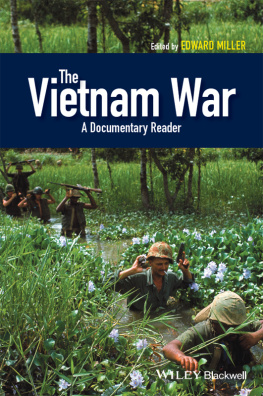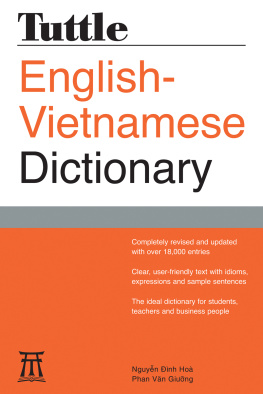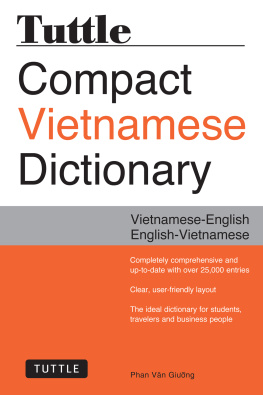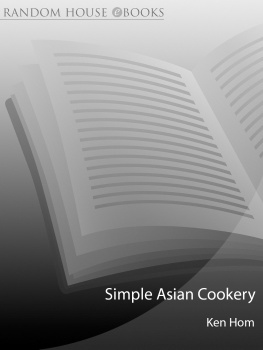Jill Nhu Huong Miller - Vietnamese cookery
Here you can read online Jill Nhu Huong Miller - Vietnamese cookery full text of the book (entire story) in english for free. Download pdf and epub, get meaning, cover and reviews about this ebook. year: 1989, publisher: Tuttle Publishing, genre: Home and family. Description of the work, (preface) as well as reviews are available. Best literature library LitArk.com created for fans of good reading and offers a wide selection of genres:
Romance novel
Science fiction
Adventure
Detective
Science
History
Home and family
Prose
Art
Politics
Computer
Non-fiction
Religion
Business
Children
Humor
Choose a favorite category and find really read worthwhile books. Enjoy immersion in the world of imagination, feel the emotions of the characters or learn something new for yourself, make an fascinating discovery.
- Book:Vietnamese cookery
- Author:
- Publisher:Tuttle Publishing
- Genre:
- Year:1989
- Rating:5 / 5
- Favourites:Add to favourites
- Your mark:
- 100
- 1
- 2
- 3
- 4
- 5
Vietnamese cookery: summary, description and annotation
We offer to read an annotation, description, summary or preface (depends on what the author of the book "Vietnamese cookery" wrote himself). If you haven't found the necessary information about the book — write in the comments, we will try to find it.
Vietnamese cookery — read online for free the complete book (whole text) full work
Below is the text of the book, divided by pages. System saving the place of the last page read, allows you to conveniently read the book "Vietnamese cookery" online for free, without having to search again every time where you left off. Put a bookmark, and you can go to the page where you finished reading at any time.
Font size:
Interval:
Bookmark:

BASIC RECIPES
THERE ARE A FEW recipes that do not fit into any of the other chapters and that are basic to Vietnamese cooking. These have been gathered into this chapter.
| COOKED RICE | Four servings |
If you have an automatic, electric rice cooker, follow the simple directions that come with it. If you do not have one, and have never learned to cook rice in the oriental way, be sure to try this recipe. It is quick and very simple. Notice that there is no salt or other seasoning added. When cooked this way, the rice has a gentle but very nice flavor of its own. In the orient, rice is not normally eaten alone, but has something put on top of it. The things you serve with it, usually placed on top of the rice in a rice bowl for each individual, will give the rice all the seasoning it needs. Minute rice is in a different category; don't bother to try it with this recipe.
Heavy 4-qt. pot with lid
2 cups rice
1 cups cool water
Wash the rice 2 or 3 times in cool tap water, changing the water each time and rubbing gently between the hands. The last water should be fairly clear. This will remove much of the starch covering the outside of the rice and will keep it from being too sticky. If highly refined rice is used it will need less rinsing and rubbing. Put the rice in a heavy pot and add water. Cover the pot and place on high heat until it boils. Watch carefully to be sure it doesn't boil over. Cook, covered, over high heat about 5 minutes. Lift the lid, and if you can't see much, or any, water over the top of the rice, and little holes appear in in the surface, remove it from the heat. Leave the high heat turned on, so it will be really hot when you return the rice to the burner. Drain the remaining water off the rice, and return it to the burner. Cover, and turn heat to the lowest setting. Let the rice sit on the heat, covered, from 20 to 30 minutes. Resist the temptation to uncover it and peekthat lets the steam escape and the rice may end up being too hard. Do not stir at all after it begins to cook, or it will probably get mushy.
The rice should be soft, but firm, and the grains should stick together enough to be picked up comfortably with chopsticks. Western-style cooked rice, with each grain fluffy and determinedly separate, is very hard to eat with chopsticks.
If you find that the rice in the very botton is slightly stuck to the pot, and slightly hard, cherish it! This is a delicacy. Eat it with any juice from meat dishes, etc. Vietnamese children beg for it.
| POT ROASTED RICE | Four servings |
This recipe for rice results in a true delicacy, the Vietnamese version of a type of rice cooked in many parts of Asia and the Near East. The Vietnamese often use pork fat or cooking oil instead of butter. Butter gives a delicate flavor that is very pleasant, but the other ways of cooking are also very good. This is good eaten alone, or with NUOC MAM SAUCE (page 23). It is usually cooked to accompany TOMATO-FRIED CHICKEN (page 81), but you will find it is good with almost any main dish. It is also the basic ingredient for a simple home-style meal of leftovers as described in the recipe on page 85 for MANY-COLORED CHICKEN FRIED RICE.
2 cups rice
Wash the rice thoroughly, then drain in a strainer or colander until almost completely dry again.
2 tbsp. butter (or pork
fat or cooking oil)
Heavy skillet
Melt the butter in the skillet on medium heat. Add rice and saute, stirring gently with a spatula or a spoon, for about 15 minutes on medium or medium high heat. The rice will begin to change color, the individual grains becoming whiter and more opaque and the panful of rice beginning to take on a faint golden tinge from a distance. Some grains of rice will begin to turn a golden brown around the edges.
1 cups hot water
Heavy pot with lid
Pour the rice into the heavy pot, and add about 1 cups water. The water should cover the rice completely, and stand above the level of the rice about inch. Cover the pot, turn on high heat. If it boils over, remove from the heat; your pot is not big enough or not heavy enough, or perhaps both! After about 4 or 5 minutes, check the water, which should no longer be visible. Stir rice with chopsticks, or a fork, gently, from the bottom up, to fluff it. Do not stir very much. Cover the pot, and turn the heat to low. Continue to cook about 15 or 20 minutes, or until done. The rice should be tender, but may still be slightly chewy and will stick together enough to be eaten with chopsticks. Individual tastes differ. Some people prefer softer rice, and will need to add another cup of water. Others prefer a dryer rice, and may add cup less water. Keep warm until served. It may be steamed to reheat as a leftover.
TO SERVE
Serve as regular steamed or boiled rice, but plan to serve more per person!
TEA
Making tea is easy. Any kind of tea is all right, but Chinese tea or jasmine tea is preferable. Tea is not sweetened, creamed, or lemoned in Vietnamunless "foreign" tea is being served. It is often served warm or cool, sometimes with ice, in a large glass. When served hot, especially to a guest, a cup is used.
Teapot
Hot water
Use any size teapot. Experimentation will show you the size you need. A deodorized coffee pot may be used for larger quantities. Pour hot water into the pot and let it sit for a few minutes, to warm the pot. Discard the water.
1 tbsp. tea leaves
1 qt. boiling water
Put the tea leaves in the bottom of the pot. Pour the boiling water over the leaves and let it steep for about 5 minutes. Pour out into glasses, and let the tea cool off in the glass until it is easy to hold in the hand. Or if iced tea is preferred, add ice when the tea has cooled off.
Additional tea may be made by pouring more boiling water over the same tea leaves, letting it steep slightly longer, but do not stir it.
NUOC MAM SAUCE
Nuoc mam is to Vietnamese cooking what salt is to cooking in the Western world. And the prepared nuoc mam sauce is a basic seasoning for numerous dishes. The quantity given here is small, enough for one or two meals for those who are just experimenting. For those who like the flavor, all quantities may be multiplied by four, or ten, or whatever number is desired. Don't believe all you hear about nuoc mamit is delicious when prepared correctly and used in moderation.
Mortar and pestle
(Page 9)
3 -inch pieces fresh
hot chili pepper
1 garlic clove
1 tsp. sugar
medium lime
1 tbsp. vinegar
1 tbsp. water
4 tbsp. fishsauce
Seed the chili pepper. If you are not sure how hot you want this, start with a very little. It is easy to add more. Peel the garlic clove. Crush the pepper and garlic together in a mortar with the sugar. Peel and seed the lime and mash the pulp in the mortar with the garlic and pepper.
Add vinegar and water to pulp mixture and mix well.
Add the fish sauce (plain nuoc mam) last. If it is added before other ingredients the pieces of garlic, pepper, and lime pulp will all sink to the bottom, and it is much preferable to have them in suspension or floating on top.
This sauce can be used as soon as it is mixed, but it can also be kept for two or three months in the refrigerator. Store in a tightly closed bottle or jar.
BOILED PORK
Buy fresh ham for boiling, since it has less fat. A good lean piece is best. A green onion will counteract the slight odor of boiling pork.
1 lb. lean pork
Water to cover
Deep pot with lid
1 green onion
Put the pork in the pot, and cover with water. Put on high heat.
Font size:
Interval:
Bookmark:
Similar books «Vietnamese cookery»
Look at similar books to Vietnamese cookery. We have selected literature similar in name and meaning in the hope of providing readers with more options to find new, interesting, not yet read works.
Discussion, reviews of the book Vietnamese cookery and just readers' own opinions. Leave your comments, write what you think about the work, its meaning or the main characters. Specify what exactly you liked and what you didn't like, and why you think so.












